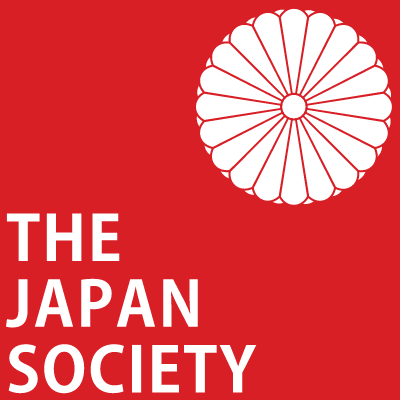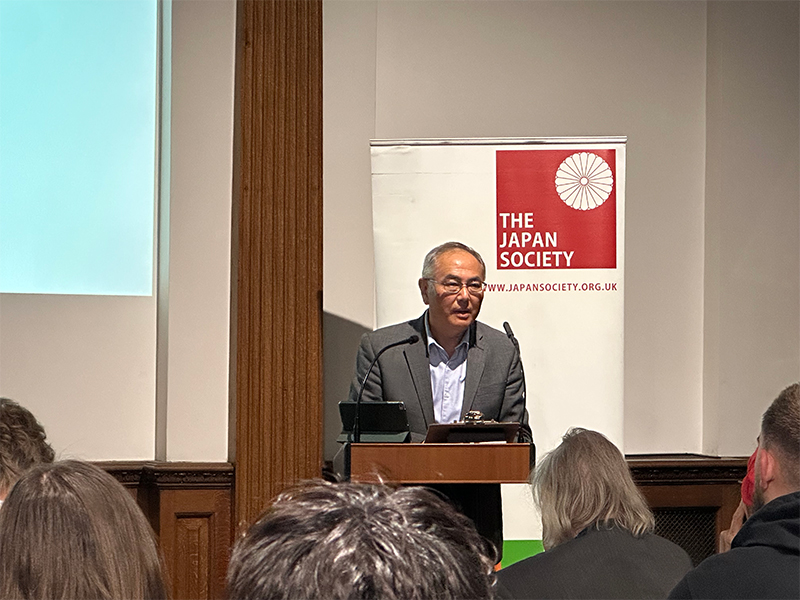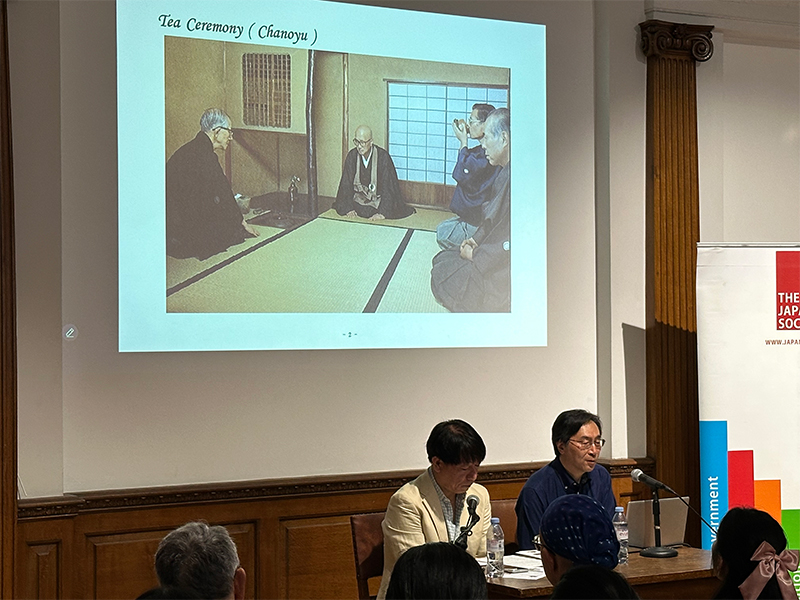The Japan Society Public Lecture Series: April – June 2025

In April, May, and June 2025, we held a fascinating series of lectures that explored the significance of Japanese ukiyo-e prints, how Japanese art was collected and presented in the UK, and the history and evolution of the Japanese tea ceremony.
We would like to thank our speakers: curators Anna Jackson and Masami Yamada, Professor Yoshi Miki, and Dr. Asao Kozu, along with everyone who attended the lectures. Special thanks to the Toshiba International Foundation for their support.
Below is a summary of the lectures conducted in April, May, and June 2025.
Click here for upcoming lectures and Join The Japan Society Mailing List to stay informed of future events.
|
Become a member of The Japan Society and have exclusive access to the video recording of most of the lectures and many more events in the "members-only" playlist on our YouTube channel. |
Using works from the Victoria and Albert Museum collection, curators Anna Jackson and Masami Yamada explored the cultural and artistic significance of ukiyo-e, iconic woodblock prints known as “pictures of the floating world,” during Japan’s Edo period. Produced mainly in the 18th and 19th centuries, these vibrant prints captured urban life and reflected shifting trends in fashion, entertainment, and social culture in Japan.
Yamada explained that the term “ukiyo-e,” originally associated with the Buddhist notion of the transient nature of life, was redefined in this period to celebrate the excitement and possibilities of urban living. She emphasized how ukiyo-e prints served not only as art but also as powerful marketing tools. Merchants and businesses, including kimono sellers, textile makers, cosmetics brands, theatre promoters, and brothel operators, used ukiyo-e imagery to advertise the latest styles and beauty trends to the public.
In the second half of the lecture, Jackson examined the close connection between fashion and social identity in Edo Japan. She highlighted how ukiyo-e prints featuring kabuki actors, geisha, and other cultural icons became visual style guides for the public. These aspirational images gave viewers access to a glamorous world beyond the rigid structures of shogunal authority, offering models of beauty and refinement that could be imitated.
Together, Jackson and Yamada demonstrated how ukiyo-e prints were far more than decorative images: they were a cultural phenomenon that bridged Japanese art, fashion, and society. Through their vivid imagery, these prints captured the spirit of the era, one that was defined by style, spectacle, and transformation.
19 May – Exhibiting Japan: Exploring how Japan is Curated and Presented in the UK - Yoshi Miki
Drawing from over 15 years of research, Professor Yoshi Miki explored the presence and legacy of Japanese art, particularly lacquerware and ceramics, in historic houses, castles, and museums across the UK. Through site visits, archival inventories, and conversations with local staff and volunteers, he traced how Japanese objects, though made for export, became deeply embedded in British history from the 17th century onward.
Focusing on locations such as Ham House, Burghley House, and Chirk Castle, Miki illustrated how Japanese cabinets, chests, and porcelain were not only luxury goods but intimate companions to their British owners. Often displayed in private rooms and used for storage, these items were admired for their beauty, especially the hidden decorations inside drawers and doors, which only the owner might enjoy. He emphasized how such pieces became cherished heirlooms, passed down through generations and integrated into British interiors.
Miki’s lecture highlighted how world expositions and collectors like Dr. Edward Morse fuelled Western interest in Japanese art during the 19th century. Museums in Glasgow, Boston, and London acquired thousands of objects, preserving traditional crafts vanishing amid Japan’s modernization. A key example is Glasgow’s 1878 Exchange Collection, in which over 1,000 contemporary works were sent from Japan through government channels to showcase modern craftsmanship. Among them were mannequins in traditional dress, later replaced in 1916 thanks to the help of Japanese students in Glasgow who felt the originals misrepresented their culture. Their push for more accurate representations reflected a desire to shape Japan’s image abroad, revealing the contrast between how Britain envisioned Japan and how the Japanese themselves wished to be seen.
Through these stories, Miki illustrated how Japanese art collections in the UK serve not only as historical artifacts but as bridges between cultures. Throughout his lecture, Miki underscored the value of dialogue, urging visitors to engage with local museums and staff, keeping these connections alive for future generations.
This lecture was in collaboration with the National Museum of Japanese History.
16 June – The Golden Age of Tea Ceremony: Rikyu, Oribe, Enshu - Asao Kozu
In this lecture, Dr. Asao Kozu illustrated the evolution of the Japanese tea ceremony (sado) through the influences of its key practitioners: Sen no Rikyu, Furuta Oribe, and Kobori Enshu. What began as a simple practice of preparing and enjoying tea (chanoyu) transformed into a unique ceremonial performance that emphasizes spirituality and elegance. Kozu’s detailed descriptions of the various tea gatherings were highly evocative, immersing the audience in each historical moment.
During Japan’s civil war era, Sen no Rikyu redefined the tea ceremony as a means of rebuilding human connections across social boundaries. He rejected the extravagance of imported wares in favour of humble, locally made objects that encouraged spiritual reflection. Rikyu’s tea gatherings were intimate affairs held in small, dimly lit rooms, often involving food, sake, and conversation among friends.
Kozu also described the major contributions of samurai tea masters Furuta Oribe and Kobori Enshu. Oribe, active during the Momoyama period, expanded the tea gathering to include more guests and introduced bold aesthetics and dramatic contrasts. Enshu, his successor in the early Edo period, brought a more refined and formal sensibility, incorporating courtly elegance, named utensils, and foreign-made objects into the ritual.
Throughout the lecture, Kozu emphasized how each tea master infused the ceremony with their own aesthetic and philosophical vision, enabling sado to evolve across generations. He argued that the tea ceremony’s longevity lies in its capacity for reinterpretation and reinvention. Rather than remaining a fixed tradition, it has become a living art, one that continually engages with the past while adapting to the present.
Supported by the Toshiba International Foundation (TIFO)





